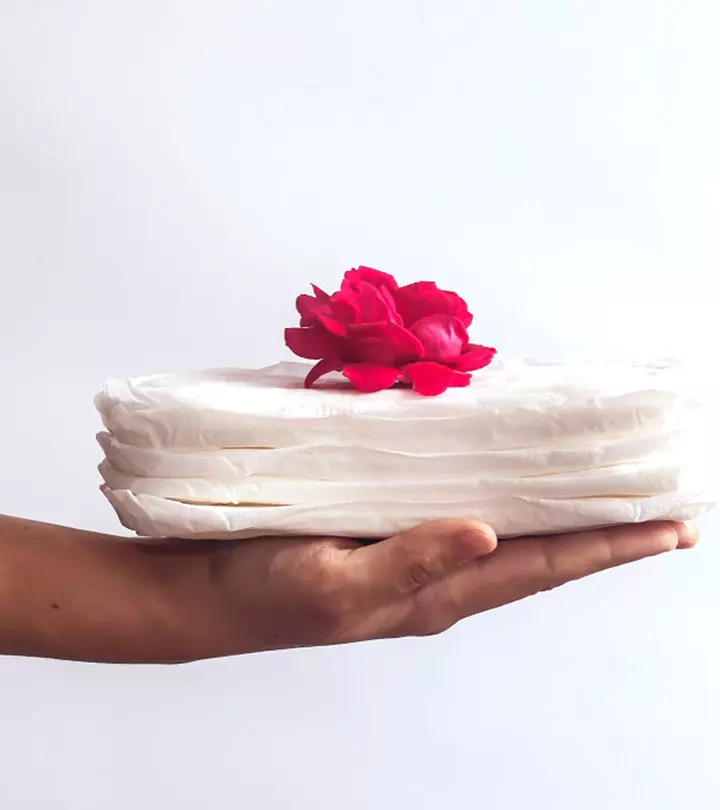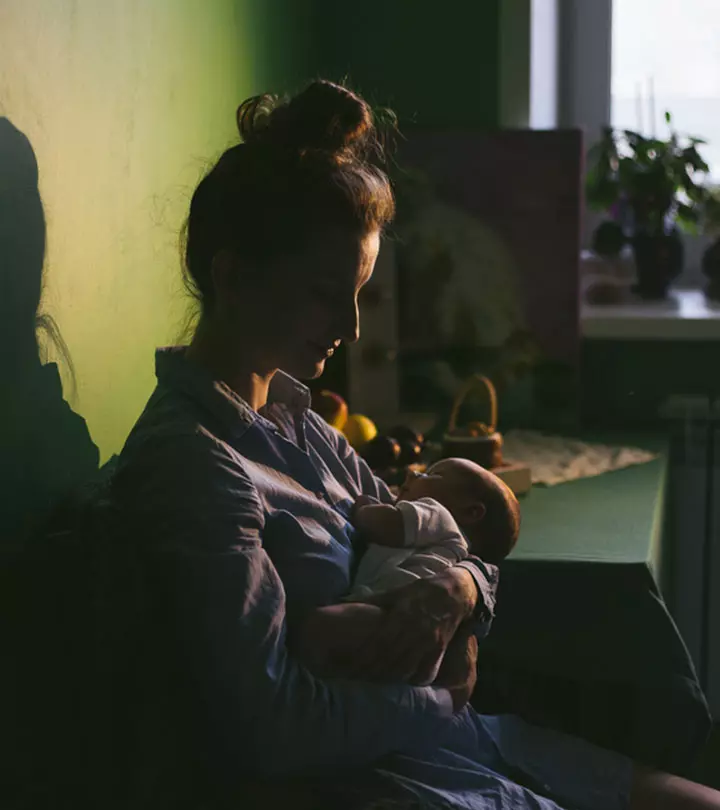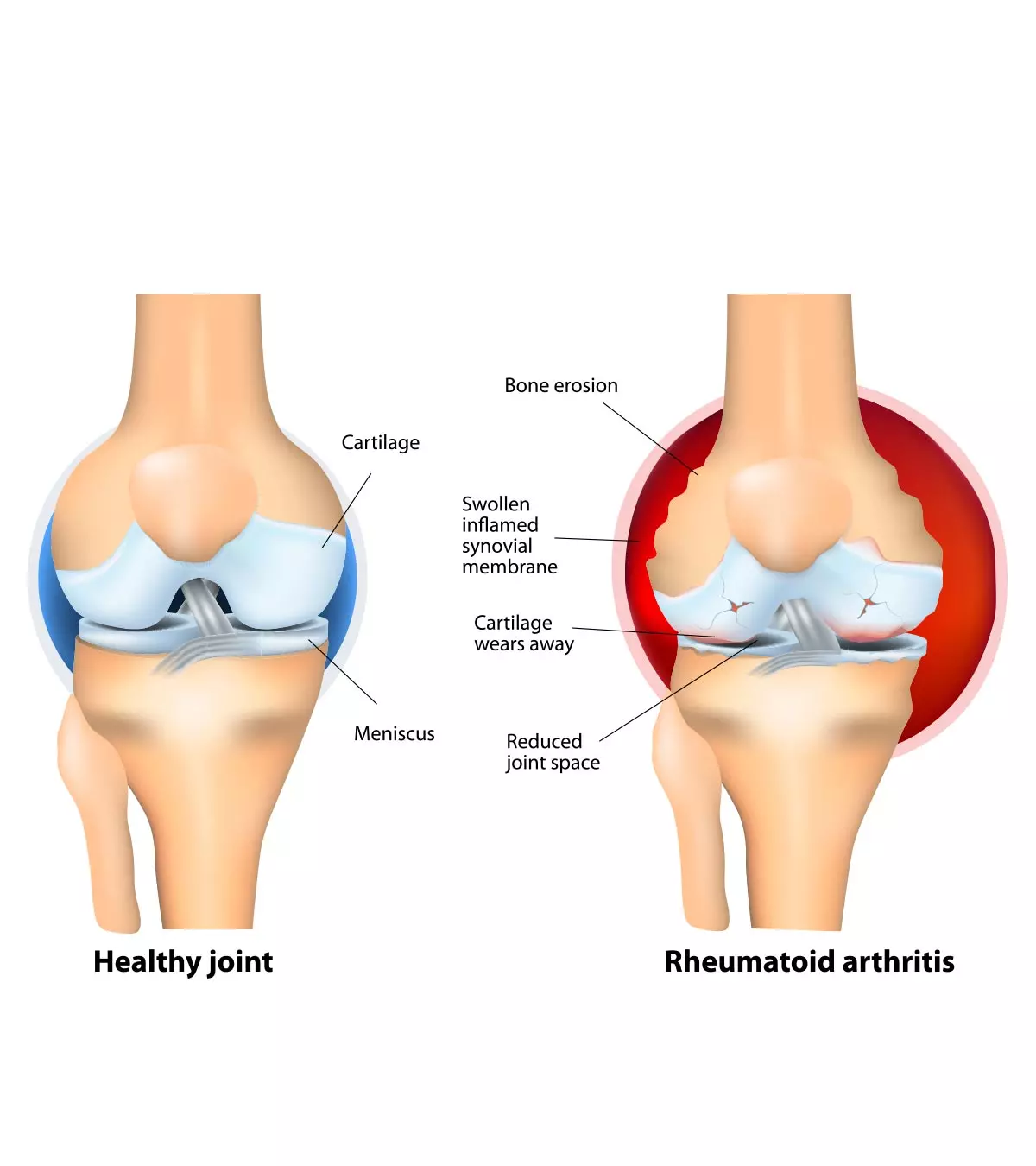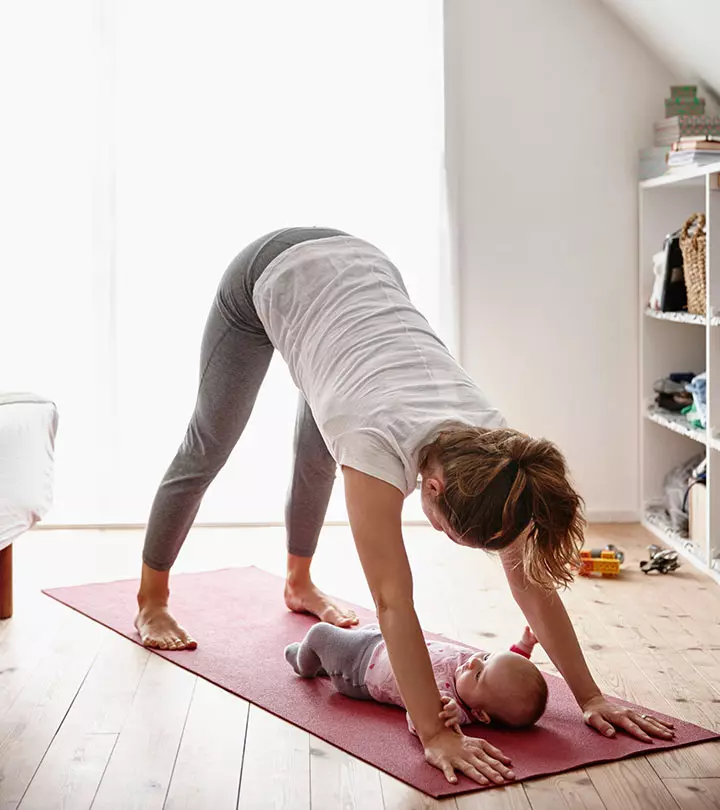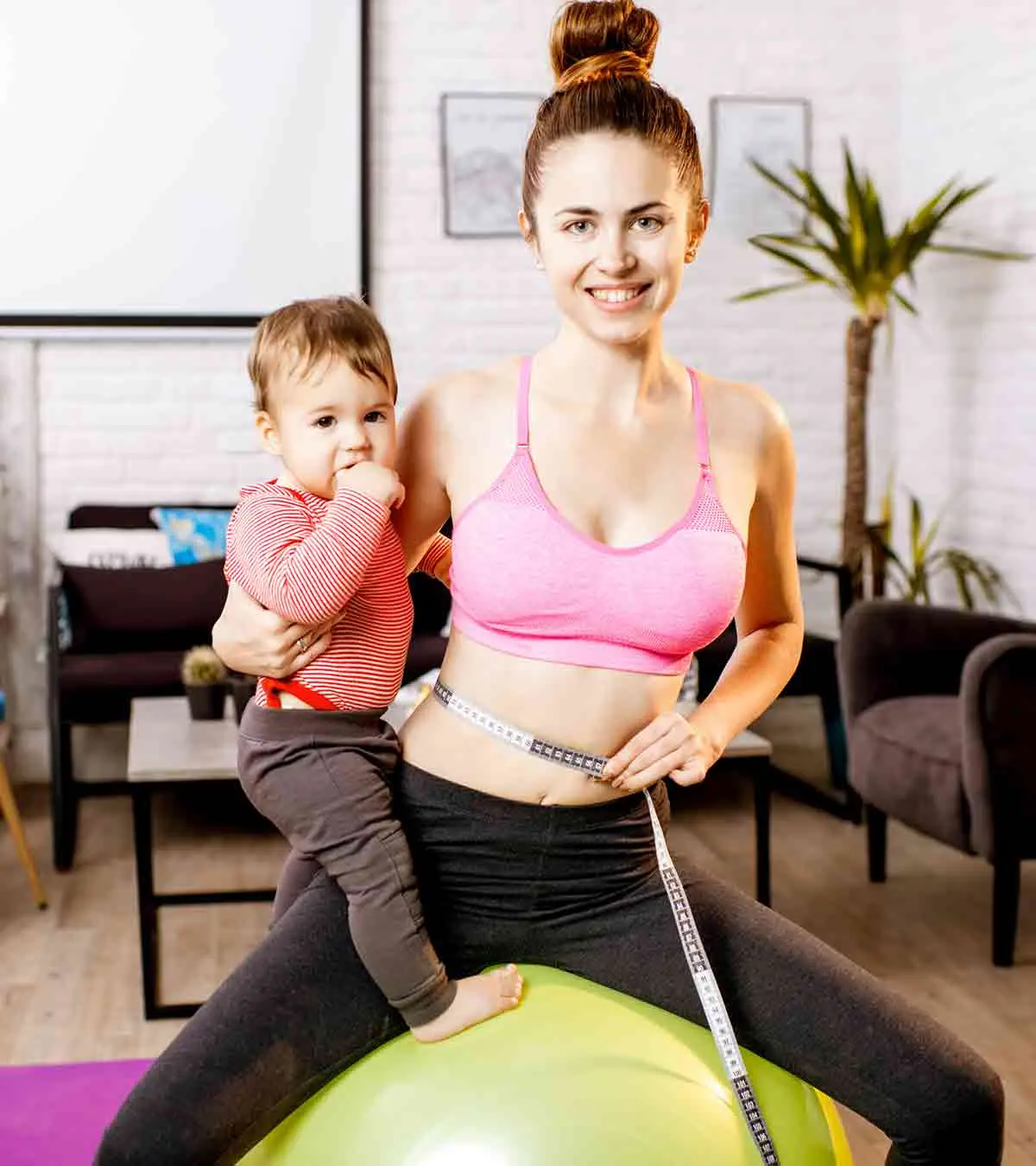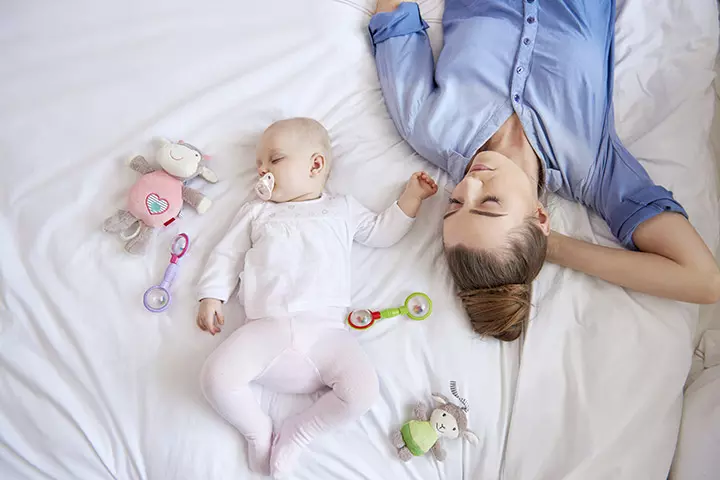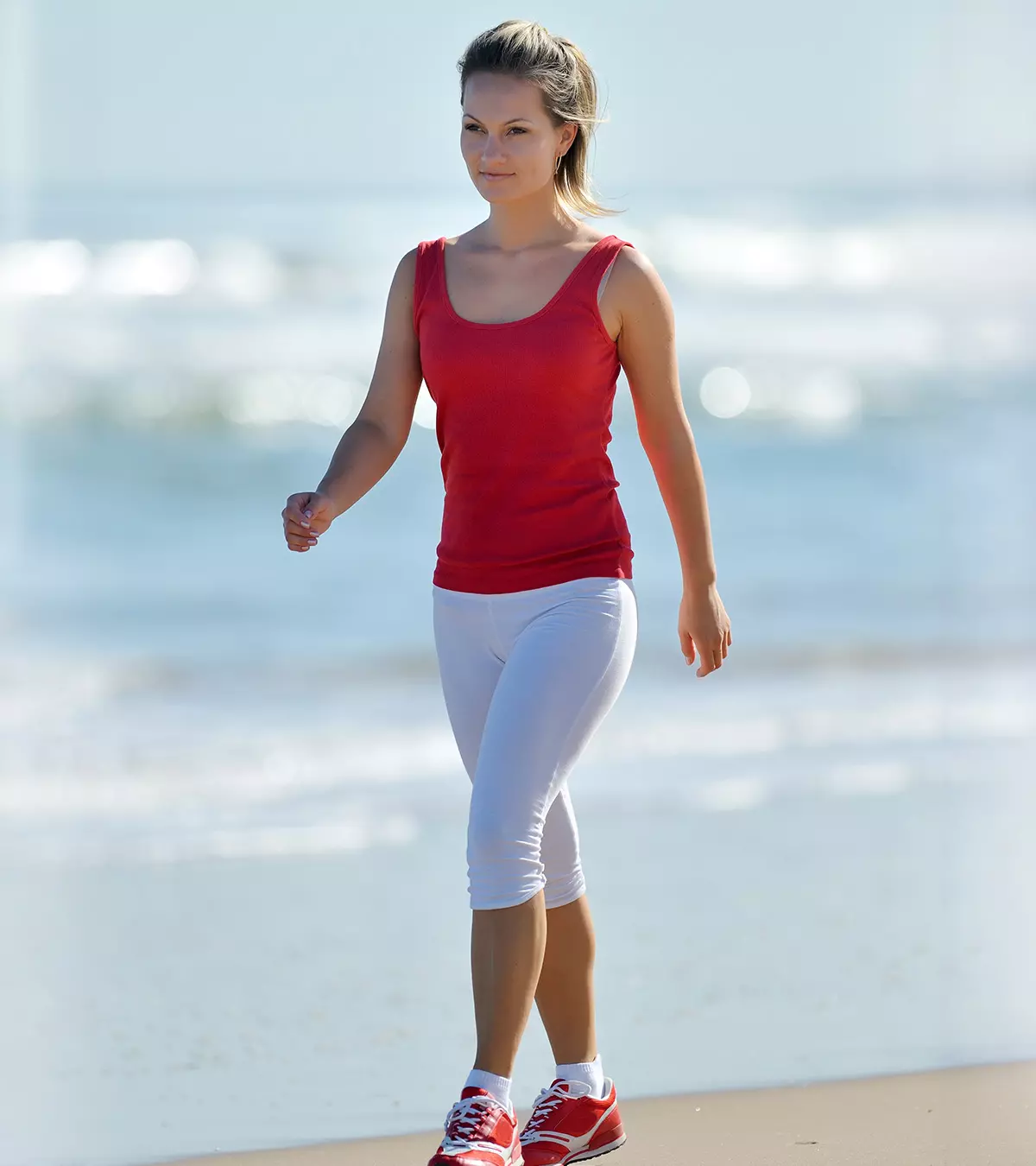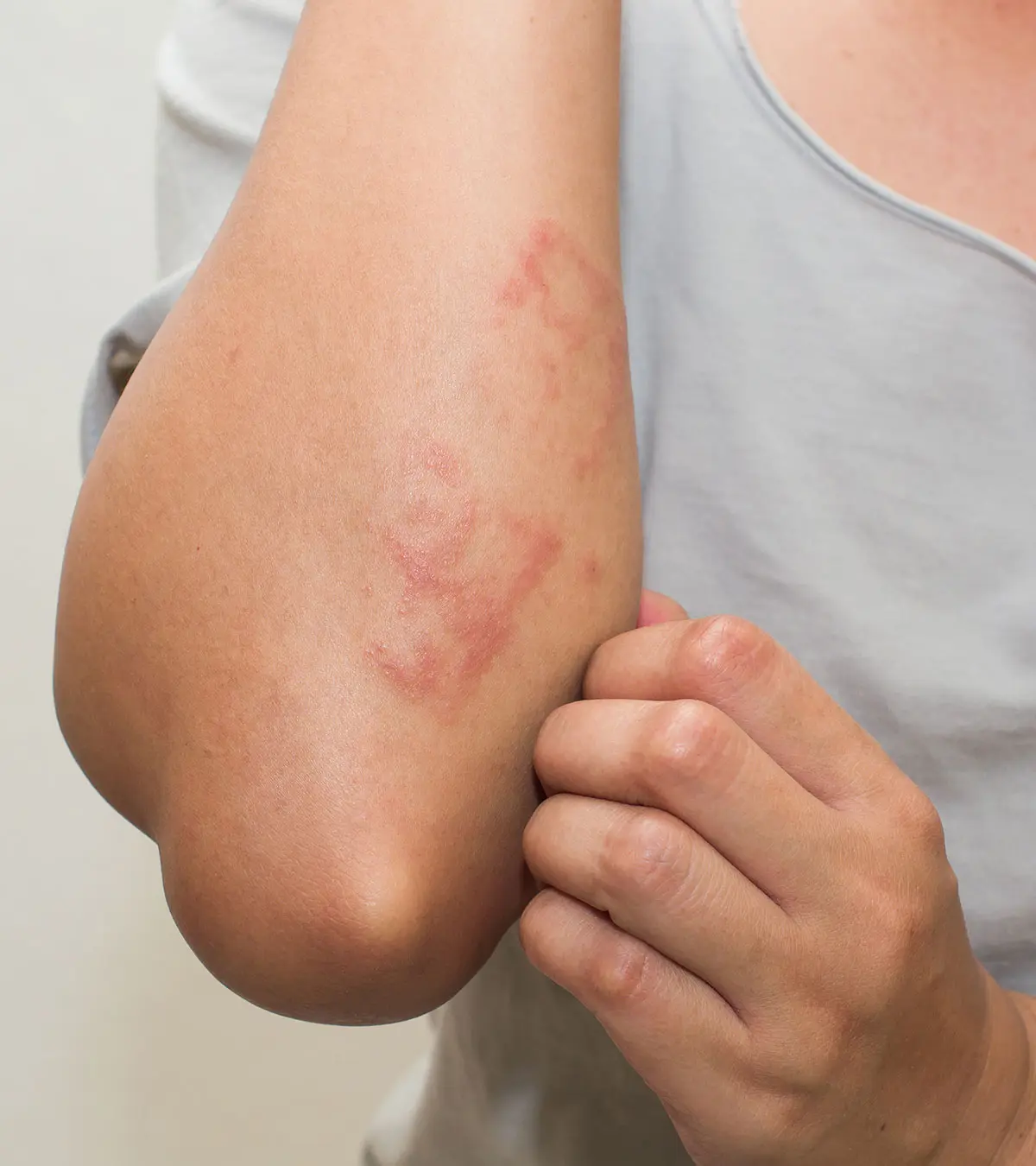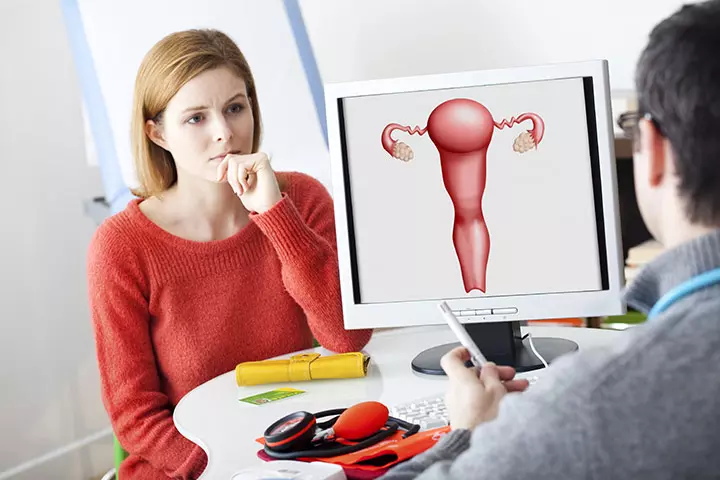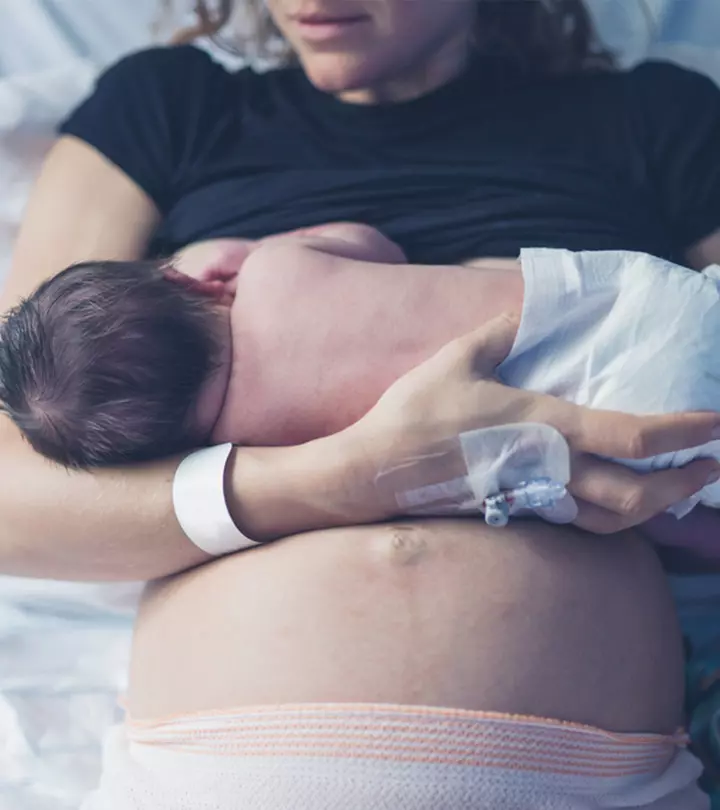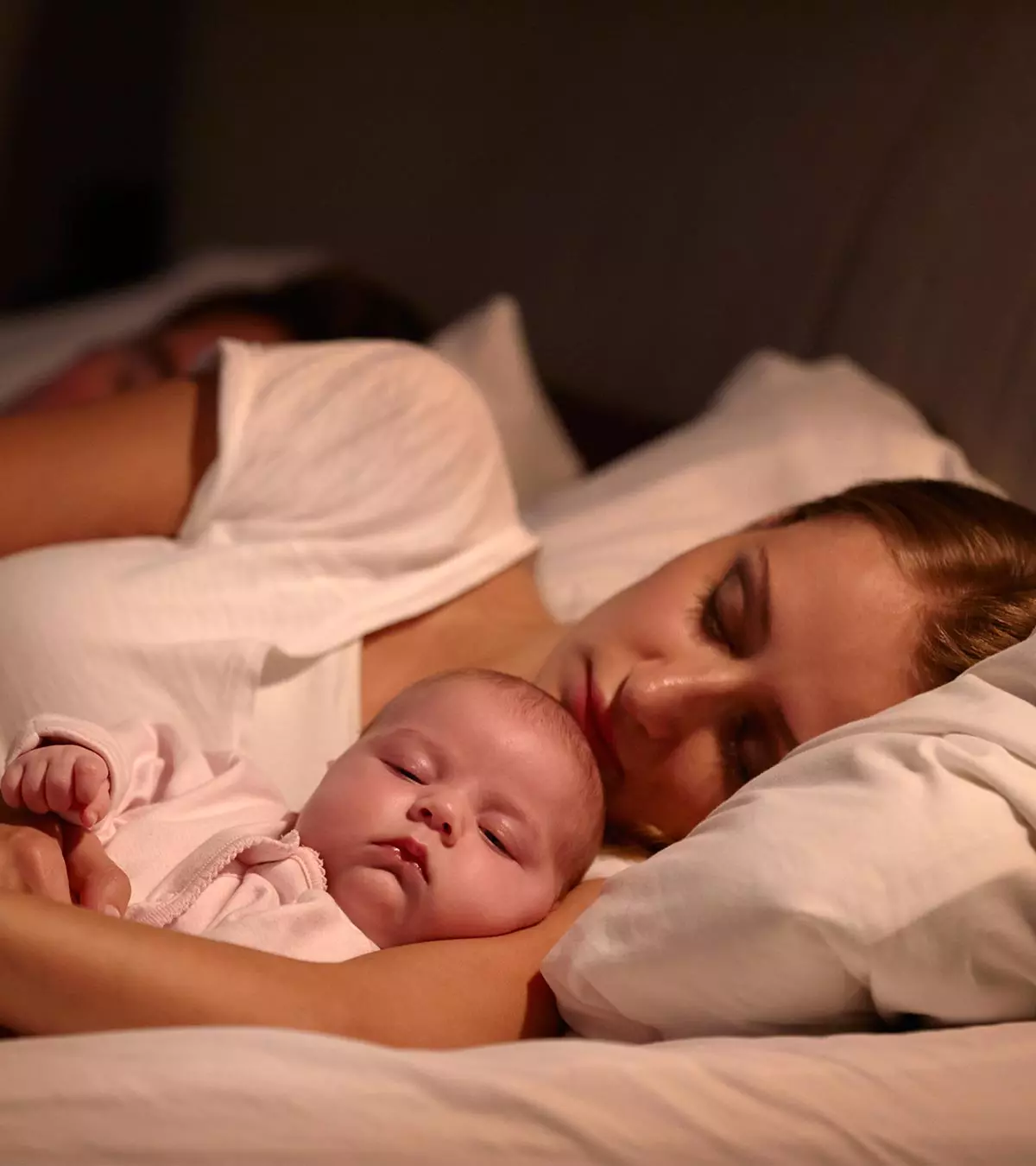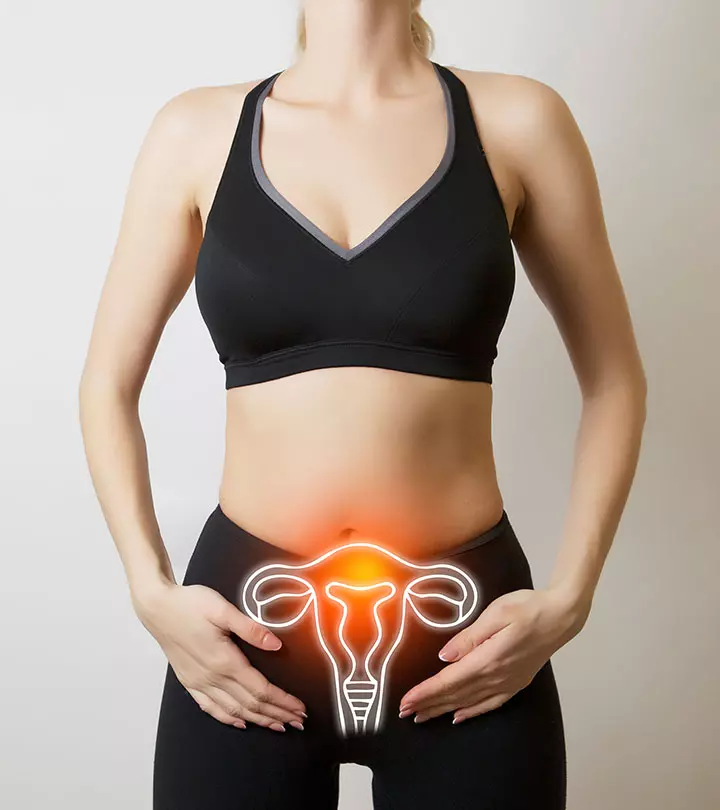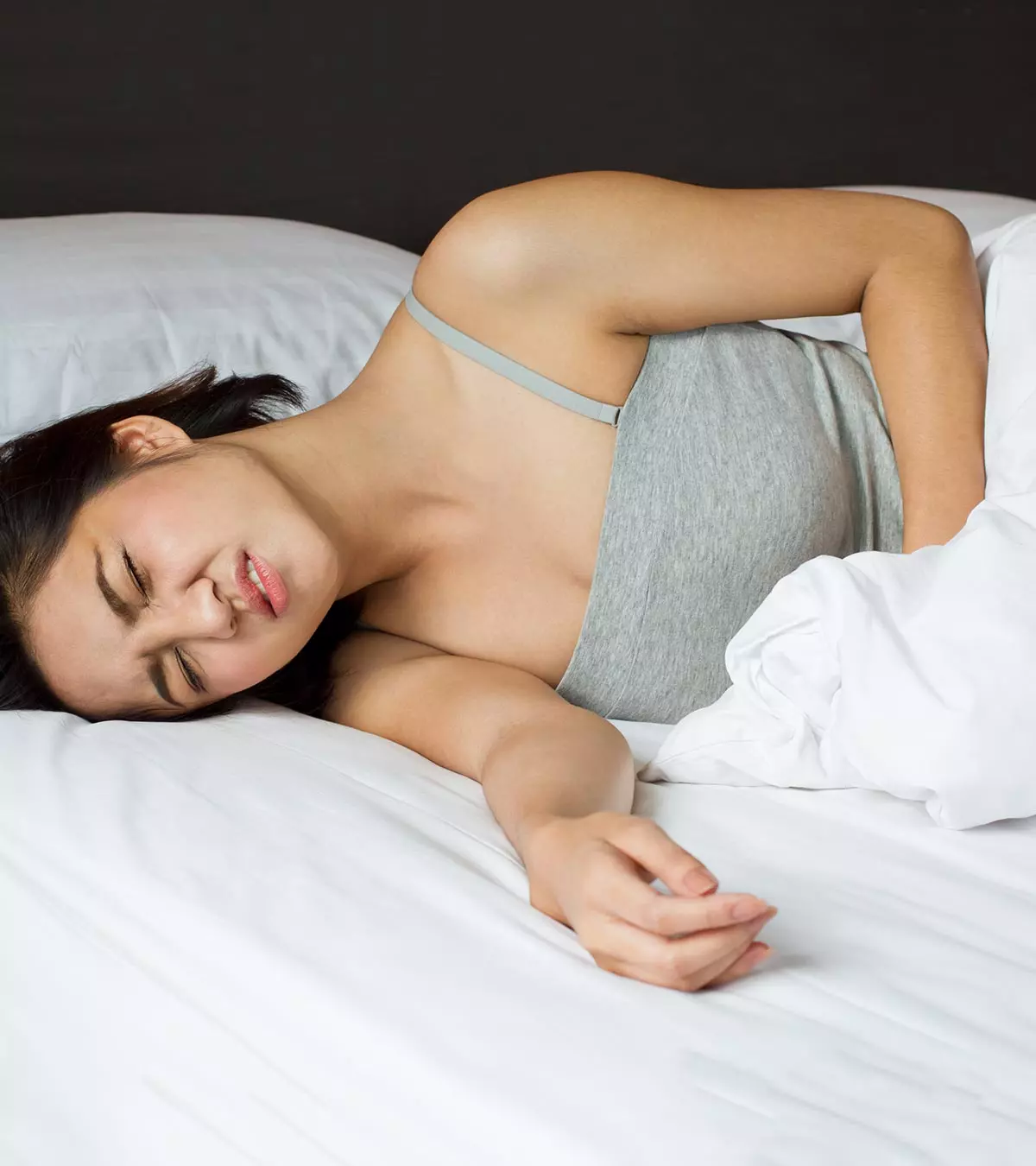
Image: Shutterstock
You may have had your share of cramps and pains during pregnancy, but why are you experiencing them even after birth? After delivery, your body takes some time to return to its pre-pregnancy state, where you will experience postpartum cramping. Postpartum cramps are uncomfortable pains that signal the body is returning to its non-pregnant state. They remain for a few days after childbirth and vary in frequency (1). The most common cause of these cramps is the uterus returning to its original size; however, there may be other causes of afterbirth pains, such as hormonal changes, stress during labor, and poor digestion. Read on to understand postpartum cramping, its causes, and ways to overcome it.
Key Pointers
- Postpartum cramps are normal as the body adjusts after delivery.
- Some common reasons for postpartum cramps are the uterus shrinking back to its pre-pregnancy size, hormonal changes, stress after delivery, and poor digestion.
- Lower abdomen discomfort can be caused by breastfeeding and persistent uterine contractions, while upper abdominal pain can be caused by infections or gut inflammation.
- Physical stress during labor can cause back pain and pelvic pain.
- Other postpartum discomforts include thigh pain, chest pain, headaches during nursing, stomach pain following a meal, and breast and hip pain.
Common Postpartum Pain and Cramps
Owing to the several bodily changes during pregnancy and the labor pains that one experiences during childbirth, it is not uncommon to experience postpartum discomfort in various body parts:
1. Back pain

You could have back pain due to your body’s physical changes during pregnancy. The physical stress during labor strains the back muscles causing pain, which remains until the muscles regain their strength in a few months. If you have a history of back pain, you may be at a higher risk of developing back pain after pregnancy. Being overweight or inactive also increases the risk (2).
2. Lower and upper abdominal pain
Lower abdominal postpartum pain could be due to prolonged contractions of the uterus and breastfeeding. Sometimes, the pain could also result from genital infections, appendicitisiThe inflammation or infection of the appendix, causing pain, digestive problems, and nausea. , ovarian cyst torsioni Twisting of the ovaries due to a large cyst. , or cyst rupturei A cyst that bursts open, causing intense pain and bleeding. (3). Upper abdominal pains are rare and may occur due to infections or gut inflammation. You should, however, let your doctor know about it.
3. Pelvic pain
During pregnancy, hormones stimulate the pelvic bones to expand and contract to aid delivery. The ligaments loosen, and any activity (even walking) causes pelvic pain after pregnancy. Postpartum pelvic pain is also due to the tear in the pelvic tissues and muscles during delivery. Pelvic pain may also be associated with difficulty with urination, pain during bowel movements, and during intercourse (4).
4. Leg pain
Postpartum leg cramps are common as the extra body weight during pregnancy exerts pressure on leg muscles. Postpartum hormonal changes relax joints and ligaments, adding to leg cramps. The intravenous fluids given during labor, sitting for a long time when nursing, lack of sleep, and deficiency of magnesium are other reasons for leg pain (5). Stating another possible reason for leg pain after childbirth, Salena Zanotti, MD, an Ob/GYN at the Cleveland Clinic, says, “After giving birth, you may be at a higher risk of blood clots, and not only from shedding the lining of your uterus. During pregnancy, your blood volume increases in order to care for the developing fetus. After giving birth, your blood may clot more easily, which can put you at a higher risk for developing blood clots in your veins, which can travel around your body and be very serious (6).”
5. Hip pain
Hip pain is normal, especially after vaginal delivery, as the hips and pelvic bones undergo trauma during delivery. If there is difficulty in delivering the baby, the use of forceps or vacuum could bruise, dislocate, or even fracture the hip area, causing further pain. But, if the pain is severe and lasts more than two weeks, you should consult a doctor (5).
6. Chest pain
Chest pain after pregnancy could be due to physically strained muscles during labor or a chest infection. It could also result from pulmonary embolism (a blood clot in the lungs blocking the lung artery). Any severe pain, shortness of breath, or coughing up blood requires immediate medical assistance (7).
7. Headaches during breastfeeding
You may experience headaches during breastfeeding due to the oxytocini Hormone released by the hypothalamus in the brain that aids in uterine contraction and lactation . hormone. This is referred to as a lactation headache. It lasts from a few weeks or could continue until the baby weans off the breastfeeding. These headaches could also be from fatigue and lack of sleep or a sign of preeclampsia. However, consult your doctor if you have constant headaches (8).
8. Stomach pain post-eating

Stomach ache after consuming food is common due to gastric inflammation or poor digestion or occasionally due to anal incontinenceiThe inability to control bowel movements. . One could also experience uncontrollable gas that lasts up to six months after delivery. If you have lactose intolerance or have a diet filled with whole grains, beans, fruits, and vegetables, it can increase the risk of stomach pain, cramps and discomfort (9).
9. Uterus pain
The uterus takes around six to eight weeks to return to its pre-pregnancy size after childbirth. The contractions during resizing cause postpartum uterus pain and subside in time. These pains usually get stronger with subsequent pregnancies (10). According to the American College of Obstetricians and Gynecologists (ACOG), these afterbirth pains most commonly occur during the first few days of breastfeeding (11).
10. Breast pain
In the first week after childbirth, breasts feel bigger and tender due to the first breast milk (colostrum). Irrespective of whether you breastfeed, there will be breast engorgement causing postpartum breast pain. The pain will go away in a few days, but if it stays longer, you should check with a doctor (12). Several studies show that the prevalence of breast pain caused due to breastfeeding is experienced by 90% of all postpartum women (13).
11. Thigh pain
The pelvic region ligaments stretch and cause sharp pains or dull aches during labor, that extend into the thighs. The pain is also attributed to pushing efforts during labor and exhausting muscles. It subsides in a few weeks (14).
Besides the above, the ribs ache, the abdomen begins to throb, the back turns sore, and the joints such as wrists, ankles, and others also hurt. These pains are due to the contractions and pressure the body has gone through during labor. The positions while nursing and holding your baby also add to postpartum aches in the body (15).
Causes Of Pain And Cramps After Delivery
Other factors besides pressure and strain on the body result in post-delivery pain.
- Uterus contraction: During pregnancy, the uterus expands up to 25 times its normal size and is as large as a basketball. It then shrinks to the size of a tiny pear. This shrinkage can cause afterbirth pains and cramps or ‘involution’ (16).
- Breastfeeding: The baby’s sucking stimulates the production of oxytocin, leading to contractions and pain (17).

- Cesarean delivery: According to the World Health Organization, up to 21% of deliveries in 2021 were done through cesarean section globally (18). If you have had a C-section, you may experience a pulling sensation or post-delivery pains in the abdominal region which may last for a few months (19). The incision from the surgery also takes time to heal and causes pain around the lower abdomen.
 Point to consider
Point to consider- Constipation: You may experience bowel movements after a few days of childbirth. An observational study doneon pregnant and postpartum women in Finland in 2021 suggests that the prevalence of constipation is higher during postpartum than in pregnancy and that women who underwent cesarean are at higher risk than those with vaginal delivery (20). Initially, the experience would be painful due to hemorrhoidsiA condition in which the rectal and anal region veins get swollen. and perineum tearsi A tear in the region between the anus and the vagina (perineum) during vaginal delivery. (11).
 Quick tip
Quick tip- Infections after delivery: Although the risk of postpartum infections is low, women may experience pain if they have any of these conditions.
- Postpartum endometritis is a bacterial infection that women may develop within ten days of childbirth. The symptoms may sometimes be seen even after six weeks of delivery (21). According to the study report of the National Library of Medicine, postpartum endometritis can occur in 1-3% of normal spontaneous vaginal deliveries. However, cesarean delivery increases the risk of this condition by five to 20-fold (22).
- Bacterial vaginosis is a common infection caused by the overgrowth of bacteria in the vagina. Along with the pain, you may also experience foul-smelling discharge, itching, and burning sensations (23).
- Urinary tract infections occur in two to four percent of women after deliveries. They are generally mild but may cause pain, discomfort, and extended hospital stay (24).
What Do Afterbirth Pains Feel Like?
Afterbirth pains are as severe as menstrual cramps and labor contractions. They are mild in the first-time moms and worsen with subsequent deliveries as uterine muscle tone in first-time mothers is better compared to moms with multiple deliveries (25).
Treatment For Postpartum Cramps
You can manage postpartum pains with self-care, prescription, and over-the-counter medications. If you are breastfeeding, it is safe to take ibuprofen and acetaminophen for pain relief. Numbing sprays and laxatives may be used if you have a perineal tear or episiotomyiA cut made between the anus and the vagina (perineum) for smooth delivery of the baby. . However, before following any treatment, you should discuss its safety and dosage with your doctor. For breast engorgement and pain, see a lactation consultant (11).
Home Remedies For Relieving Afterbirth Pains
If your doctor gives you the go-ahead, you can try these home remedies, which help relieve postpartum cramps.
1. Hot water compress
Hot water treatment is the best way to cure the unpleasant abdomen tenderness as it loosens the contracted uterus and improves blood circulation, relieving lower abdominal and uterus pain (26).
2. Rice water
Rice water is known to improve digestive health in the case of gastroenteritis and other digestive problems (27). Cook the rice in extra water and drink the strained water twice a day. This water soothes the stomach region, improves digestion, and prevents constipation.
3. Ginger tea
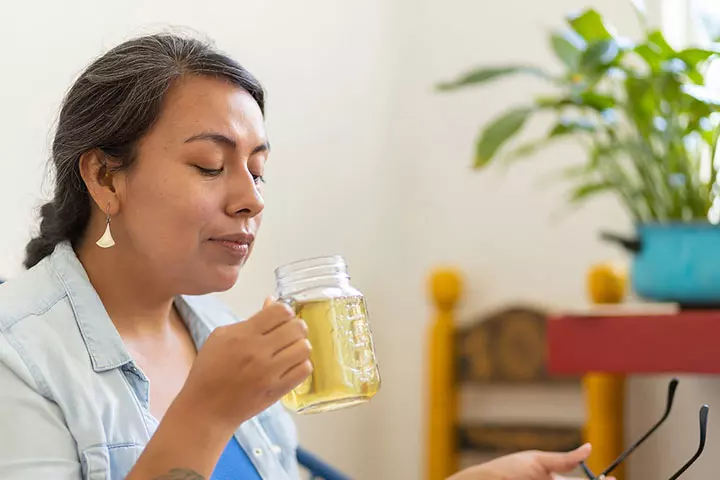
Ginger is anti-inflammatory and an excellent astringent and antiseptic, preventing pains and cramps after birth. Make ginger tea by adding some grated ginger to a cup of boiling water. You can also add ten parsley leaves and boil them together for some time. Add honey to taste and have it twice a day (28).
4. Fennel tea
Fennel seeds also have anti-inflammatory and analgesic properties that relieve post-pregnancy pains (29). Prepare fennel tea by adding two tablespoons of fennel seeds to two cups of water. Boil for ten minutes, cool it down and add honey for taste. You could have it twice a day.
5. Warm water bath
Bathing in warm water will help alleviate hip and uterus pains. You could soak in a bathtub for about 30 minutes, but ensure the temperature is not so hot. Try it twice a day to ease pains and soothe skin (11).
6. Lemon tea
Most postpartum problems are due to weakened immune systems. You should take more vitamin C, which is abundant in lemon or Indian gooseberry. Boil one cup of water, let it cool, and then add lemon juice squeezed from two lemons. Drink it twice a day to boost your immune system, and it also helps in relieving stomach cramps (30).
7. Fresh mint
Mint has soothing properties, which help relieve abdominal pains and headaches (31). Therefore, it may also provide relief from postpartum cramps and headaches. Add mint leaves to a cup of boiling water, and allow it to simmer for around ten minutes. Strain, cool it down, and add lemon juice before drinking. Drinking it twice a day will reduce abdominal pains and cramps.
8. Chamomile tea
Chamomile helps relieve pains due to uterine involution. It is considered safe by the US FDA (Food and Drug Administration). Add dry chamomile blossoms to a cup of boiling water. Allow it to steep for ten minutes, strain, and have it. You could add honey and lemon for additional flavor. Drink it twice daily to relieve uterine cramps and contractions after delivery (32).
9. Oil massage
You can ask your partner to massage your abdomen with an oil mix. For a gentle massage, place hands on the navel and move in a circular motion, as this will stimulate contractions and make your uterus firm. To make an oil mix, take five drops of lavender oil, ten drops of cypress oil, 15 drops of peppermint oil, and one-ounce carrier oil (jojoba, olive, sweet almond, or coconut oil) (33). Check with your doctor to learn if you can get a professional postpartum massage, as it may help reduce pain and speed up your recovery after delivery. The data collected from the 2024 randomized controlled experimental study conducted by the Republic of Turkey Ministry of Health, Turkey, and Health Sciences Faculty of Selcuk University, Turkey, suggested that hand massage can significantly improve postpartum pain in women after cesarean birth (34).
 Quick tip
Quick tipSteph, a mother of three, a doula, and a nurse, shares her postpartum recovery journey after surgical birth and the teas she included in her diet. She shares her setup for the recovery: “Nourishing infusions made the night before (more on that below), a quart jar for water by the bedside, and fennel-fenugreek tea in a thermos made fresh every morning. This was essential to establishing my milk supply and keeping both baby and I well hydrated, nourished, and rested.” She further shares what she did to take care of her hemorrhoids and pains. She says, “I also use 1/2 cup epsom or sea salt in any sitz bath I take within the first week or two postpartum, and keep organic witch hazel extract on hand for hemorrhoids (i).”
How To Ease Pregnancy Cramps: A Few Other Ways

Other than the home remedies, you can try some additional tips that help alleviate the pain and intensity of postpartum cramps.
- Pee often: Pee often, even if you do not have the urge. A full bladder makes you uncomfortable, displaces the uterus, and worsens cramps.
- Take deep breaths: Practice deep breathing techniques and meditation as they can help in uterus contraction and relieve you from afterbirth cramps.
- Sleep face down: You may consider lying face down with a pillow under your belly. It will help you get rid of the pain.
When To See A Doctor
Postpartum cramping and pain are normal and get better with time. However, if you experience pain that prevents you from doing your everyday activities, you should see a doctor. These are some conditions that you should not avoid (11):
- Chest pain
- Seizures
- Cough and breathlessness
- Swelling and tenderness in the legs
- Headache that causes vision changes
- Fever higher than 100.4°F
- Nausea and vomiting
- Pain and burning sensation while urination
- Painful lumps on the breasts
- Heavy bleeding that soaks two sanitary pads in an hour
Frequently Asked Questions
1. When can I feel normal again after having a baby?
Healing after pregnancy depends on your physical health and the type of delivery. Some conditions, such as vaginal pain, may last for a few days, while others, such as pelvic girdle pain and bleeding, may remain for a few weeks. In the first two weeks, you may also experience anxiety and depression (36). Most women feel normal in four to six weeks. In the case of cesarean delivery, the numbness and pain may last a little longer (37).
2. How long do afterbirth pains last?
It takes about six to eight weeks for the uterus to return to its pre-pregnancy size, and severe pains last only for one or two days post-delivery (38) (39). If the pains last longer, then consult a doctor. Pain and emotional stress during breastfeeding may have an adverse effect on milk production. In an interview with NIH Pain Consortium, Dr. Pervez Sultan, a Professor of Obstetric Anesthesiology at Stanford University School of Medicine, says, “A significant part of postpartum recovery happens after the parent leaves the hospital. This highlights the need for more research in the postpartum period to improve health outcomes (such as pain, sleep, and psychological issues) (40).”
3. How long should I stay in the house after having a baby?
Although resuming work postpartum depends on several factors, staying in the house for at least 6-8 weeks is recommended and avoiding strenuous chores for at least two weeks after having a baby to allow for adequate rest and postpartum recovery. This period might be longer if you had a c-section or experienced complications during delivery (41).
4. How long should I avoid stairs after giving birth?
When recovering during the first week after giving birth, it is best to avoid climbing and restrict daily trips up and down stairs. Contact your healthcare practitioner if you experience discomfort ascending stairs after a few weeks (42).
It is not uncommon for women to experience postpartum cramping. Afterbirth pains continue until the body returns to the non-pregnant state and are seldom a cause of worry. You can feel these postpartum cramps in the back, abdomen, pelvis, legs, hips, chest, head, thighs, breasts, or other body parts. Discuss the pain with your gynecologist. Not all women experience cramps, but if you do, rest assured as it will mostly settle down in a few days. In addition, some home remedies may help you manage these pains.
Infographic: Home Remedies For Relieving Afterbirth Pains
Afterbirth pains, also known as postpartum contractions, are common after childbirth. Although these pains can cause discomfort and may last for several days, you may try these home remedies to help relieve the pain. If these measures fail to work or the pain worsens, speak to your healthcare provider. Illustration: Momjunction Design Team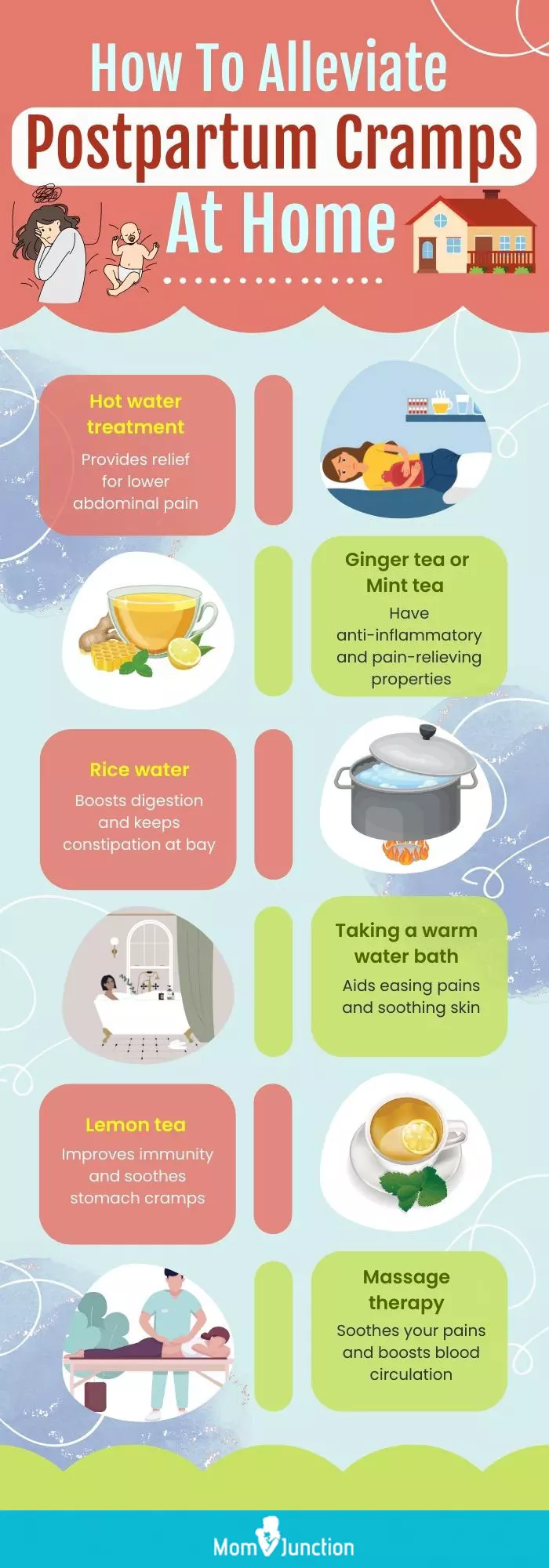
Illustration: What Causes Postpartum Cramping And How To Get Rid Of It?

Image: Stable Diffusion/MomJunction Design Team
After giving birth, cramping can be a normal part of the postpartum period. Learn what you can do to help ease the discomfort from this video.
Personal Experience: Source
MomJunction articles include first-hand experiences to provide you with better insights through real-life narratives. Here are the sources of personal accounts referenced in this article.
i. Creating Your Babymoon: A Guide to a Healing Postpartum;https://medium.com/@witchnursesteph/creating-your-babymoon-a-guide-to-a-healing-postpartum-64ffa10aada3
References
- Pain Management.
https://www.urmc.rochester.edu/ob-gyn/obstetrics/after-delivery/pain-management - Post-partum back pain: Why does this happen?
https://www.hss.edu/article_exercise-after-pregnancy.asp - A. Murray and A. Holdcroft; (1989); Incidence and intensity of postpartum lower abdominal pain.
https://www.ncbi.nlm.nih.gov/pmc/articles/PMC1836902/?page=1 - Laurel Q P Paterson et al.; (2009); Persistent genital and pelvic pain after childbirth.
https://pubmed.ncbi.nlm.nih.gov/19170851/ - V J Vullo et al.; (1996); Hip knee and foot pain during pregnancy and the postpartum period.
https://pubmed.ncbi.nlm.nih.gov/8691182/ - 10 Postpartum Symptoms Not To Ignore.
https://health.clevelandclinic.org/whats-normal-and-not-after-you-give-birth?utm_source=chatgpt.com - J S MacGregor et al.; (1991); Pleuritic chest pain in a postpartum woman.
https://www.ncbi.nlm.nih.gov/pmc/articles/PMC1285797/?page=1 - David A. Webb et al.; (2013); Postpartum Physical Symptoms in New Mothers: Their Relationship to Functional Limitations and Emotional Well-being.
https://www.ncbi.nlm.nih.gov/pmc/articles/PMC3815625/ - Capt. R. F. Christoph And Capt. E. W. Pinkham; Unexpected Rupture of the Stomach in the Postpartum Period.
https://www.ncbi.nlm.nih.gov/pmc/articles/PMC1465834/pdf/annsurg00855-0108.pdf - Anita Holdcroft et al.; (2003); Pain and uterine contractions during breast feeding in the immediate post-partum period increase with parity.
https://pubmed.ncbi.nlm.nih.gov/12927631/ - Postpartum Pain Management.
https://www.acog.org/womens-health/faqs/postpartum-pain-management - Nikolay P. Alekseev et al.; (2015); Pathological Postpartum Breast Engorgement: Prediction Prevention and Resolution.
https://www.ncbi.nlm.nih.gov/pmc/articles/PMC4410447/ - Ruth Lucas et al.; (2020); Efficacy of a Breastfeeding Pain Self-Management Intervention: A Pilot Randomized Controlled Trial (RCT).
https://pmc.ncbi.nlm.nih.gov/articles/PMC6400324/ - Jill M. Thein-Nissenbaum et al.; (2012); Low Back and Hip Pain in a Postpartum Runner: Applying Ultrasound Imaging and Running Analysis.
https://pubmed.ncbi.nlm.nih.gov/22446476/ - Postnatal Care Module: 3. The Abnormal Puerperium.
https://www.open.edu/openlearncreate/mod/oucontent/view.php?id=337&printable=1 - E R Cluett et al.; (1997); What is the normal pattern of uterine involution? An investigation of postpartum uterine involution measured by the distance between the symphysis pubis and the uterine fundus using a paper tape measure.
https://pubmed.ncbi.nlm.nih.gov/9171584/ - Louise Wen et al.; (2015); The impact of breastfeeding on postpartum pain after vaginal and cesarean delivery
https://pubmed.ncbi.nlm.nih.gov/25468582/ - Caesarean section rates continue to rise amid growing inequalities in access.
https://www.who.int/news/item/16-06-2021-caesarean-section-rates-continue-to-rise-amid-growing-inequalities-in-access - What Every Pregnant Woman Needs to Know About Cesarean Section.
https://health.usf.edu/~/media/Files/Public%20Health/Chiles%20Center/FPQC/What-Every-Pregnant-Woman-Needs-to-Know-ChildbirthConnection.ashx?la=en - M Kuronen et al.; (2021); Pregnancy puerperium and perinatal constipation – an observational hybrid survey on pregnant and postpartum women and their age-matched non-pregnant controls.
https://pubmed.ncbi.nlm.nih.gov/33030260/ - Postpartum Endometritis.
https://www.birthinjuryhelpcenter.org/birth-injuries/prenatal-problems/maternal-infections/postpartum-endometritis/ - Michael Taylor et al.; (2023); Endometritis.
https://www.ncbi.nlm.nih.gov/books/NBK553124/ - BACTERIAL VAGINOSIS AND PREGNANCY.
https://www.marchofdimes.org/find-support/topics/pregnancy/bacterial-vaginosis-and-pregnancy - Tina Djernis Gundersen et al.; (2018); Postpartum urinary tract infection by mode of delivery: a Danish nationwide cohort study.
https://www.ncbi.nlm.nih.gov/pmc/articles/PMC5857667/ - Vaginal delivery – discharge.
https://medlineplus.gov/ency/patientinstructions/000628.htm - What to Know After Having Your Baby.
ttps://hsc.unm.edu/health/patient-care/womens-health/maternity-care/doc/postpartum-information.pdf - UAB Health Education STUDENT HEALTH SERVICES GASTROENTERITIS (“STOMACH FLU”).
https://www.uab.edu/students/health/images/Patient-Education-materials/SHS_PatientEd_Gastroenteritis.pdf - Vichith Lamxay et al.; (2011); Traditions and plant use during pregnancy childbirth and postpartum recovery by the Kry ethnic group in Lao PDR.
https://www.ncbi.nlm.nih.gov/pmc/articles/PMC3120637/ - Katarzyna Budzynska et al.; (2013); Complementary Holistic and Integrative Medicine: Advice for Clinicians on Herbs and Breastfeeding.
https://www.ncbi.nlm.nih.gov/pmc/articles/PMC4530286/ - The Surprising Benefits of Hot Water and Lemon.
https://flushinghospital.org/newsletter/the-surprising-benefits-of-hot-water-and-lemon/ - Peppermint.
https://www.mountsinai.org/health-library/herb/peppermint - Janmejai K Srivastava et al.(2011); Chamomile: A herbal medicine of the past with bright future.
https://www.ncbi.nlm.nih.gov/pmc/articles/PMC2995283/ - Farideh Vaziri et al.; (2017); Effect of Lavender Oil Aroma in the Early Hours of Postpartum Period on Maternal Pains Fatigue and Mood: A Randomized Clinical Trial.
https://www.ncbi.nlm.nih.gov/pmc/articles/PMC5439291/ - Sinem Değirmenci and Yasemin Erkal Aksoy; (2024); Effects of hand massage on women’s pain comfort levels and flatulence times after caesarean section: A randomized controlled study.
https://www.sciencedirect.com/science/article/abs/pii/S2212958824001162 - Breastfeeding After Cesarean Birth.
https://llli.org/breastfeeding-info/breastfeeding-cesarean-birth/ - Your body after the birth (the first 6 weeks).
https://www.tommys.org/pregnancy-information/after-birth/your-body-after-birth - Postpartum: First 6 Weeks After Childbirth.
https://www.peacehealth.org/medical-topics/id/abl1277 - Uterus Involution.
https://my.clevelandclinic.org/health/diseases/22655-uterus-involution - Uterus Involution.
https://my.clevelandclinic.org/health/diseases/22655-uterus-involution - Andrea R Deussen et al.; (2020); Relief of pain due to uterine cramping/involution after birth.
https://pmc.ncbi.nlm.nih.gov/articles/PMC8094397/ - Women Should Rest For A Month After Childbirth—Myth Or Fact?
https://healthcare.utah.edu/the-scope/shows.php?shows=0_4ekbzznm - Caring for Your Health After Delivery
https://my.clevelandclinic.org/health/articles/postpartum
Community Experiences
Join the conversation and become a part of our nurturing community! Share your stories, experiences, and insights to connect with fellow parents.
Read full bio of Dr. Anita Gondy
Read full bio of Pragya Bhargavi
Read full bio of Rebecca Malachi
Read full bio of Dr. Joyani Das






